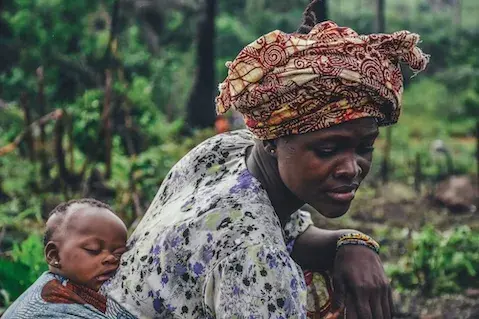Good policies that can be immediately scaled up
Package to avoid undernutrition: (BCR of 14).
Africa’s future success lies in increasing human knowledge. Mostly, this means education, but there is another, possibly more effective way. Malnourished children suffer cognitive impairment, leading to lower schooling and lower productivity. Children, that are better nourished during the first 1000 days (in utero and the first two years of life), will do better. In Zimbabwe, shifting a child from being stunted to well-nourished is equivalent to increasing schooling by 1.25 grades. In general, avoiding stunting increases adult wages by a whopping 66%.
The policy proposes to ensure well-nourished children by investing in 10 interventions from salt iodization, over micronutrients, calcium and energy supplementation during pregnancy, to vitamin A, zinc, breastfeeding promotion, free food supplementation and feeding education, along with management of severe acute malnutrition. All of this will cost an additional $130 per child. The benefit will be to avoid stunting for 20% of children.
Every child helped by this package will on average see 12% higher wages. As the new generations make their way into society, it will increase national wealth. Yet, these higher wages will only occur when the children become adults, and continue way into the second half of this century. The present-day value of the increased productivity is $1,768 per child. Each dollar spent will produce almost $14 of social benefits.
It is likely the real BCR is higher, as the current analysis only look at wage increases until 50, whereas most will work longer, and does not include the benefits of avoided premature deaths.
Lower household air pollution with improved cookstoves: (BCR of 12).
Household air pollution kills more than 400,000 in Africa each year, and two-thirds are due to the use of solid cooking fuels, such as wood. The pollution could be reduced with more efficient cook stoves, either burning wood better (improved cookstoves) or with gas (LPG), but this is only used by 12% of the population in Sub-Saharan Africa.
The policy provides two improved stoves, replaced every 5 years, and include costs for maintenance and promotion to increase attention and demand. Over ten years, this will cost $111 per household or about $13bn over the next decade for full coverage of the entire continent. It will reduce household air pollution by 35-50%, and avoid 67,000 premature deaths each year. It will save 20 minutes of cooking time, freeing up valuable time, often for the women. Finally, because the improved cookstove is more effective, it needs 40% less wood. Given that an average household uses 2.1 hours a day collecting wood, this frees up 50 minutes. The saved time is valued at half the average wage rate. Over a decade, a family with two improved cookstoves sees slightly lower death risk worth $200, while saving half a year worth of time from cooking and collecting firewood, worth about $1,100. In total, each dollar spent delivers $11.7 in social benefits.
Gas, while much cleaner, is also much more expensive, and will likely deliver $2.5 of social benefits on each dollar spent.
Integrated Soil Fertility Management from cell phone: (BCR of 10, range of 3-18).
Can a mobile phone app on integrated soil fertility management practices increase the productivity and yield of smallholder farmers in Africa? An integrated approach that is adapted to local conditions, traditions and practices has recently been noted as a high impact approach to increasing yield. Several studies have shown that such Integrated Soil Fertility Management (ISFM) has a high impact on crop yield.
A challenge is the ability to reach the numerous smallholder farmers. Attempts at using local media e.g. radio broadcasts have their own shortcomings; the broadcast time may be inconvenient for the farmer, feedback sessions, troubleshooting issues will be difficult to incorporate in a radio broadcast.
The suggested intervention involves developing a mobile phone application and loading it with information and feed-back mechanisms for specific a crop and a specific agricultural zone, which is estimated to cost $193,000 per application with an annual maintenance cost of $34,000. This cost is held up against the value of the potential yield increase for the users of the application.
The benefit to cost ratio over a 5-year period varies from 3 to 18 with the number of smallholder farmers served (900 to 2,000) and the yield value for the crop increase. However, the benefits exceed the costs already after the first year for all analyzed mobile applications.
Voluntary medical male circumcision: (BCR of 10 in a range of 1.2-45).
At $90 per person in Sub-Saharan Africa, male circumcision is one of the most effective and cost-effective HIV prevention interventions. However, benefits depend strongly on age of circumcision, prevalence and treatment coverage. Circumcision of 15 years olds will help avoid HIV infection for the male, his female and possible male partners, along with consequent mother-to-child transmission across entire sexual career. The effectiveness declines sharply for individuals older than 20.
With higher HIV prevalence, circumcision protects more and lead to higher benefits. With higher treatment coverage, circumcision has less to prevent and hence has lower benefits. With 20% HIV prevalence, 81% treatment coverage and focusing on 15-year olds, each dollar spent delivers $10 of social benefits. (Botswana has 22.8% prevalence and 84% treatment.) With a lower treatment rate of 50% at 20%, the benefits reach $45 per dollar spent (South Africa is close at 18.8% prevalence and 61% treatment). With 81% treatment and 10% prevalence, like Zambia, the benefits drop to $5, and with just 5% prevalence, like Kenya, it drops to $3. This is not a policy for nations with negligible HIV prevalence.
Reduced adolescent pregnancy through education: (BCR of 10).
More than 20,000 girls under the age of 19 years give birth every day in low- and middle-income countries, and while declining globally, it has remained constant in Sub-Saharan Africa. Adolescent pregnancy has higher risks for mother and child, with the young mother three times more likely to die during pregnancy, and making pregnancy the second-leading cause of death for 15-19 year old girls. It also school drop-outs, and lost productivity.
The policy proposes comprehensive sexual and reproductive health education from grade 4-8, taught one hour per week by health extension workers. Based on estimates from rural Ethiopia, the annual costs are $2 per girl. The benefits for a million girls by postponing adolescent pregnancy a few years will be to avoid 359 maternal deaths and 980 infant deaths, along with saved health care costs, valued at 10.2 times the cost.
10% Marine Protected Areas: (BCR of 9).
Marine ecosystems provide services like nutrition, coastal protection, recreational opportunities and climate regulation. Unfortunately, they are degrading around Africa, with currently just 0.02% of Africa’s territorial waters protected. The policy proposes to increase Marine Protected Areas to 10% in 561 MPAs. The costs would consist of $90m per year in management of the MPAs, and about $1,220 m per year in lost fishing incomes from the areas closed to fishing, especially livelihoods for small-scale fisheries. However, the benefits would be substantial, at about $12.4bn a year. These come from increased benefits to fisheries elsewhere, as the MPAs act as hatcheries to sustain fisheries elsewhere along with tourism and recreation and coastal protection, biodiversity, and carbon sequestration. In total, each dollar spent will provide $9.2 in social benefits. In addition, the analysis shows that increasing protection further to 30% is unlikely to provide benefits much larger than the costs.
Rural access to basic water: (BCR of 9).
Water is crucial for life and health, and central to the promises of the SDGs. Basic water means an improved water source with collection time (including queuing) of no more than 30 minutes. Yet, Africa is trailing other regions in access, with 17% of rural households using more than 30 minutes and only 46% of rural areas in Sub-Saharan Africa having at least basic water access.
Ensuring full access to basic drinking water for rural areas in Africa by 2030 will cost $26.7bn or about $2.5bn per year, with half being capital cost, the other half capital maintenance and annual operations cost. Yet, the benefits are much higher at $243bn, meaning each dollar spent provides $9.1 of social benefits. The benefits relate to both health benefits and time savings of reduced time spent collecting water (for mainly women and children), and financial savings related to seeking less health care.


